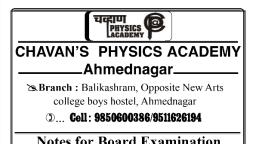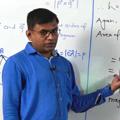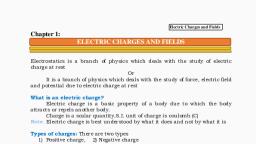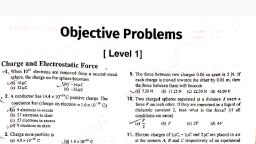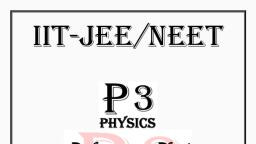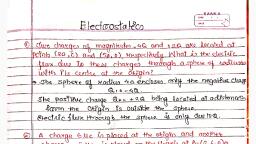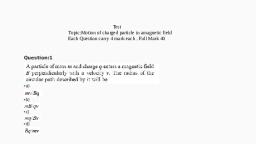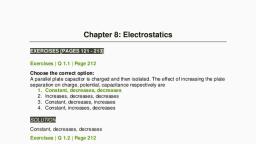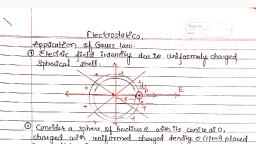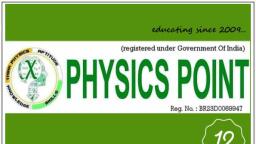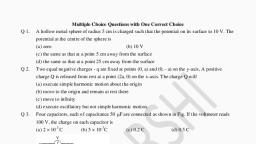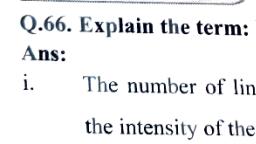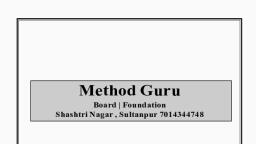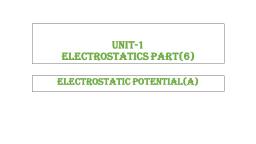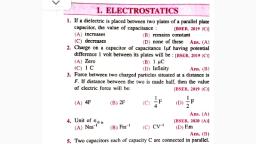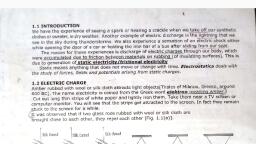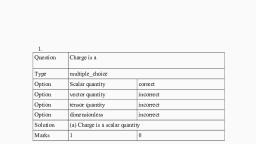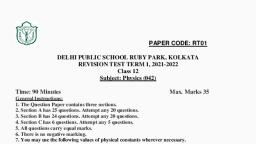Page 1 :
, Charge, Unit and dimensional formula, S.I. unit of charge is Ampere sec = coulomb (C), smaller, S.I. units are mC, C., C.G.S. unit of charge is Stat coulomb or e.s.u., Electromagnetic unit of charge is ab coulomb, 1, , 1𝐶 = 3 × 109 𝑠𝑡𝑎𝑡𝑐𝑜𝑢𝑙𝑜𝑚𝑏 = 10 𝑎𝑏𝑐𝑜𝑢𝑙𝑜𝑚𝑏., , Vector form of coulomb’s law: Vector form of, →, 𝑸 𝑸, Coulomb’s law is 𝑭 = 𝑲. 𝟏 𝟐 →, 𝒓, 𝟏𝟐, , 𝟏𝟐, , 𝒓𝟑, , , , Electric Field, It is the region around the charge in which another, test charge experiences electric force, ⃗ ): The electric field intensity at, Electric field intensity (𝑬, any point is defined as the force experienced by a unit, , Dimensional formula [𝑄] = [𝐴𝑇], , Effect of Charge on Mass, , ⃗ =, positive charge placed at that point. 𝑬, , ⃗𝑭, ,𝑬, 𝒒𝟎, , =, , 𝑲𝑸, 𝒓𝟐, , Unit and Dimensional formula, 𝑁𝑒𝑤𝑡𝑜𝑛, 𝑐𝑜𝑢𝑙𝑜𝑚𝑏, , It’s S.I. unit –, Neutral, , 𝑣𝑜𝑙𝑡, 𝑚𝑒𝑡𝑒𝑟, , =, , 𝐽𝑜𝑢𝑙𝑒, 𝑐𝑜𝑢𝑙𝑜𝑚𝑏×𝑚𝑒𝑡𝑒𝑟, , and C.G.S. unit – Dyne/stat coulomb., Dimension: [𝐸] = [𝑀𝐿𝑇 −3 𝐴−1 ], , Physical Significance of Electric Field, , –, , +, , =, , M, M'' > M, , M' < M, , , Distribution of Charge, (a), Line charge distribution: Charge on a line e.g., charged straight wire, circular charged ring etc., Charge, , 𝜆 = Length =Linear charge density, 𝐶, , S.I. unit is 𝑚, Dimension is [L–1TA], (b), Surface charge distribution: Charge distributed, on a surface e.g. plane sheet of charge, conducting sphere,, , , conducting cylinder of, + + +, 𝜎=, , Charge, Area, , S.I. unit is, , =Surface charge density, 𝐶, ,Dimension, 𝑚2, , is [L–2TA], , +, , +, +, , +, , +, , +, +, , +, , +, , Charge, Volume, , S.I. unit is, , , =Volume charge density, 𝐶, ,, 𝑚3, , Dimension is [L–3TA], , Coulomb’s Law, , +, +, +, +, , +, , +, , +, , +, +, +, , If charge is positive then force is directed in the, direction of field while if charge is negative force acts on, it in the opposite direction of field, , Electric Potential Energy(U), Work done in bringing the given charge from infinity to a, point in the electric field is known as potential energy of, the charge. Potential can also be written as potential, , , +, , +, , F = QE ., , +, +, , +, +, , Q1 Q 2, r, , 2, , i.e., F =, , kQ 1 Q 2, r2, , (k =Proportionality constant), , In C.G.S. (for air)𝑘 = 1, 𝐹 =, In S.I. (for air) k =, 𝐹=, , 1, 𝑄 𝑄, . 1 2, 4𝜋𝜀0 𝑟 2, , 1, 4 0, , 𝑄1 𝑄2, 𝑟2, , = 9 10 9, , Dyne, , N -m 2, C2, , Newton (1 Newton = 105 Dyne), , 𝑸𝟏 𝑸𝟐, 𝒓, , Potential at a point in a field is defined as the amount of, work done in bringing a unit positive test charge, from, infinity to that point along any arbitrary path (infinity is, point of zero potential). Electric potential is a scalar, 𝑾, , quantity, it is denoted by V. 𝑽 = 𝒒, , 𝟎, , 𝑽=, , 𝑲𝑸, 𝒓𝟐, , C2, N −m, , formula is [𝑀−1 𝐿−3 𝑇 4 𝐴2 ], 9653671710, , 2, , (=, , 𝐹𝑎𝑟𝑎𝑑, )., 𝑚, , It’s Dimensional, , 𝑱/𝑪, , Unit and dimensional formula, Joule, = volt, Coulomb, , Dimension: [V ] = [ML2T −3 A −1 ], , C.G.S. unit: Stat volt (e.s.u.); 1 volt =, , 1, 300, , Stat volt, , Relation Between Electric Potential Energy and Electric, Potential, U=QV, ∆𝑼 = 𝑸∆𝑽, , Relation Between Electric Field and Potential, , 𝜀0 =Absolute permittivity of air or free space, = 8 .85 10 −12, , J, , Electric Potential(V), , S.I. unit :, F, , 𝑼=𝒌, , energy per unit charge. i.e., , (c), Volume charge density: Charge distributes, throughout the volume of the body e.g. charge on a, , dielectric sphere etc., + + +, 𝜌=, , Relation between electric force and electric field:, , In an electric field E a charge (Q) experiences a force, , ⃗ ∙ 𝒅𝒓 = −𝑬 𝒅𝒓 𝑪𝒐𝒔𝜽, 𝒅𝑽 = −𝑬, 𝒅𝑽, 𝑬=−, 𝒅𝒓, ELECTROSTATICS
Page 2 :
, , Equipotential Surface, , For a given charge distribution, locus of all points, having same potential is called “equipotential surface”, regarding equipotential surface following points, should keep in mind:, The direction of electric field is perpendicular to the, equipotential surfaces or lines., , Electric Dipole, , Work done in rotation: Suppose initially, dipole is kept, in a uniform electric field at an angle 1. Now to turn it, through an angle 2 (with the field) Work done, W = pE(cos 1 − cos 2 ) ., +q, , 2, 1, , +q, , –q, –q, , System of two equal and opposite charges separated, by a small fixed distance is called a dipole., Dipole moment: It is defined as the product of the, magnitude of either of the charge and the dipole length, , , i.e. p = q (2 l ), , If 1 = 0o and 2 = i.e. initially dipole is kept along, the field then it turns through so work done, , It is a vector quantity and is directed from negative charge, , to positive charge along the axis. It is denoted as p and, , 1., , Its S.I. unit is coulomb-metre or Debye (1 Debye = 3.3 ×, 10–30 C m) and its dimensions are M0L1T1A1., Electric field and potential due to an electric dipole, (i) At axial point: Electric field and potential are, given as, Ea =, Va =, , 1, 2p, ., 4 0 r 3, , 1, p, ., 4 0 r 2, , W = pE(1 − cos ), , 2., , (directed from – q to +q), 3., , . Angle between E a and p is 0o., , (ii) At equatorial point: Ee =, , 1, p, . 3, 4 0 r, , (directed from, , (c) 32 C, , , , +q to – q) and Ve = 0 . Angle between E e and p is 180o., (iii) At general point:, Vg =, , 1, p cos , ., 4 0, r2, , (where tan =, , 1, , p, Eg =, ., 4 0 r 3, , (3 cos + 1), 2, , . Angle between E and, , 1, tan , 2, , p, , 4., , and, , is ( + ), , 5., , ), , Dipole in an external electric field: When a dipole is, kept in an uniform electric field. The net force, experienced by the dipole is zero as shown in fig., The net torque experienced by the dipole is, = pE sin, , 6., , →, , p, , +Q, , τ = pE, QE, , QE, , 9653671710, , 7., , , –Q, , Hence due to torque so produced, dipole align itself, in the direction of electric field. This is the position of, stable equilibrium of dipole., , Quantization of charge, A conductor has 14 .4 10 −19 coulombs positive, charge. The conductor has, (Charge on electron = 1.6 10 −19 coulombs ), (a) 9 electrons in excess (b) 27 electrons in short, (c) 27 electrons in excess (d) 9 electrons in short, Number of electrons in one coulomb of charge will, be, (a) 5.46 10 29, (b) 6.25 10 18, (c) 1.6 10 +19, (d) 9 10 11, When 10 14 electrons are removed from a neutral, metal sphere, the charge on the sphere becomes, (a) 16 C, (b) −16 C, , 8., , (d) −32 C, , The number of electrons in 1.6 C charge will be, (a) 10 19, (b) 10 20, (c) 1.1 10 19, (d) 1.1 102, Charge on -particle is, (a) 4.8 10 −19 C, (b) 1.6 10 −19 C, (c) 3.2 10 −19 C, (d) 6.4 10 −19 C, A body has – 80 micro coulombs of charge. Number, of additional electrons in it will be, (a) 8 10 −5, (b) 80 10 −17, (c) 5 10 14, (d) 1.28 10 −17, Effect of Charge, A soap bubble is given a negative charge, then its, radius, (a) Decreases, (b) Increases, (c) Remains unchanged (d) None, When a glass rod is rubbed with silk, it, (a) Gains electrons from silk (b)Gives electrons to, silk, (c) Gains protons from silk (d)Gives protons to, silk, ELECTROSTATICS
Page 3 :
9., , 10., , 11., , 12., , A body can be negatively charged by, (a)Giving excess of electrons to it, (b)Removing some electrons from it, (c)Giving some protons to it, (d)Removing some neutrons from it, One metallic sphere A is given positive charge, whereas another identical metallic sphere B of, exactly same mass as of A is given equal amount of, negative charge. Then, (a) Mass of A and mass of B still remain equal, (b) Mass of A increases, (c) Mass of B decreases, (d) Mass of B increases, When a body is earth connected, electrons from the, earth flow into the body. This means the body is, (a) Unchanged, (b) Charged positively, (c) Charged negatively (d) An insulator, An infinite line charge produces a field of, 7 . 182 10 8 N / C at a distance of 2 cm. The linear, charge density is, (a) 7 .27 10 −4 C / m, −4, , (c) 7 .11 10 C / m, 13., , 14., , 15., , 16., , (b) 7 .98 10 −4 C / m, , (c) Remains unchanged, (d) Increases if q 3 is of the same sign as q1 and, decreases if q 3 is of opposite sign, 19., , 20., , 1 km, , 21., , 22., , 23., , −4, , (d) 7 .04 10 C / m, , Effect of Dielectric, With the rise in temperature, the dielectric constant, K of a liquid, (a) Increases, (b) Decreases, (c) Remains unchanged (d) Charges erratically, Dielectric constant for metal is, (a) Zero, (b) Infinite, (c) 1, (d) Greater than 1, The value of electric permittivity of free space is, (a) 9 10 9 NC 2 / m 2, (b) 8.85 10 −12 Nm 2 / C 2 sec, (c) 8.85 10 −12 C 2 / Nm 2 (d) 9 10 9 C 2 / Nm 2, Dielectric constant of pure water is 81. Its, permittivity will be, (a) 7 .12 10 −10 MKS units (b) 8.86 10 −12 MKS units, , 24., , 18., , . If third charge q 3 is brought near, the force of, , q1, , exerted on q 2, , (a)Decreases, 9653671710, , (b) Increases, , (a) 9 10 3 Newton, , (b) 9 10 −3 Newton, , (c) 1 .1 10 −4 Newton, , (d) 10 4 Newton, , When the distance between the charged particles is, halved, the force between them becomes, (a)One-fourth, (b) Half, (c) Double, (d) Four times, +2 C and +6 C two charges are repelling each other, with a force of 12 N . If each charge is given −2C, of charge, then the value of the force will be, (a) 4 N (Attractive), (b) 4 N (Repulsive), (c) 8 N (Repulsive), (d)Zero, Two-point charges +3 C and +8 C repel each, other with a force of 40 N . If a charge of −5 C is, added to each of them, then the force between them, will become, (a) −10 N, (b) +10 N, (c) +20 N, (d) −20 N, A total charge Q is broken in two parts Q1 and Q 2, , (a) Q 2 =, , Q, Q, , Q1 = Q −, R, R, , (b) Q 2 =, , Q, 2Q, , Q1 = Q −, 4, 3, , (c) Q 2 =, , Q, 3Q, , Q1 =, 4, 4, , (d) Q1 =, , Q, Q, , Q2 =, 2, 2, , 25., , Two spherical conductors B and C having equal, radii and carrying equal charges in them repel each, other with a force F when kept apart at some, distance. A third spherical conductor having same, radius as that of B but uncharged is brought in, contact with B, then brought in contact with C and, finally removed away from both. The new force of, repulsion between B and C is, (a) F / 4, (b) 3F / 4, (c) F / 8, (d) 3F / 8, , 26., , Four charges are arranged at the corners of a square, ABCD , as shown in the adjoining figure. The force, on the charge kept at the centre O is, , The ratio of the forces between two small spheres, with constant charge (a) in air (b) in a medium of, dielectric constant K is, (a) 1: K, (b) K: 1, (c) 1 : K 2, (d) K 2 : 1, Coulomb’s Force, A charge q1 exerts some force on a second charge, q2, , apart, the force between them is, , and they are placed at a distance R from each other., The maximum force of repulsion between them will, occur, when, , (c) 1 .02 10 13 MKS units (d) Cannot be calculated, 17., , Two electrons are separated by a distance of 1Å., What is the coulomb force between them?, (a) 2.3 10 −8 N, (b) 4.6 10 −8 N, (c) 1.5 10 −8 N, (d) None of these, Two charges each of 1 coulomb are at a distance, , ELECTROSTATICS
Page 4 :
coulomb force F between the two is (Where, A, +q, , (a) Zero, (b)Along the diagonal AC, (c) Along the diagonal BD, (d)Perpendicular to side AB, , B, +2q, O, , – 2q, , +q, C, , D, , 27., , Three charges are placed at the vertices of an, equilateral triangle of side ‘a’ as shown in the, following figure. The force experienced by the, charge placed at the vertex A in a direction normal, A, to BC is, +Q, 2, 2, (a) Q /(4 0 a ), (b) − Q /(4 0 a 2 ), , e2, rˆ, r3, , (b) K, , (c) − K, , e2 , r, r3, , (d) K, , e2 , r, r3, e2, r2, , rˆ, , Effect of medium on Force, The ratio of the forces between two small spheres, with constant charge (a) in air (b) in a medium of, dielectric constant K is, (a)1: K, (b) K: 1, (c) 1 : K 2, (d) K 2 : 1, Two charges q1 and q 2 are placed in vacuum at a, , (c), , –Q, , (b), , 4 0 a 2, , q2, , 4 0 a, , 2, , 2, , +Q, , a, , B, , 3q 2, , C, , 4q 2, , 35., , 4 0 a 2, , , 1 , (d) 2 +, , , q2, , 2 4 0 a, , , , 2, , An infinite number of charges, each of charge 1 C,, are placed on the x-axis with co-ordinates x = 1, 2,, 4, 8, ..... If a charge of 1 C is kept at the origin,, then what is the net force acting on 1 C charge, (a) 9000 N, (b) 12000 N, (c) 24000 N, (d) 36000 N, Five balls numbered 1 to 5 are suspended using, separate threads. Pairs (1, 2), (2, 4) and (4, 1) show, electrostatic attraction, while pair (2, 3) and (4, 5), show repulsion. Therefore ball 1 must be, (a) Positively charged, (b)Negatively charged, (c) Neutral, (d)Made of metal, Two small spheres each having the charge +Q are, suspended by insulating threads of length L from a, hook. This arrangement is taken in space where, there is no gravitational effect, then the angle, between the two suspensions and the tension in each, will be, o, , (a) 180 ,, (c) 180 o ,, 32., , (a) − K, , the force on the charge at B will be, , , , 31., , ), , Equal charges q are placed at the four corners, A, B, C, D of a square of length a . The magnitude of, , 1 + 2 2 , , (c) , , , 30., , 1, 4 0, , distance d and the force acting between them is F, . If a medium of dielectric constant 4 is introduced, around them, the force now will be, (a) 4 F, (b) 2 F, , (a), , 29., , 33., , 34., , (c) Zero, (d) Q 2 /(2 0 a 2 ), 28., , K=, , 1, , Q2, , 4 0 (2 L) 2, 1, , Q2, , 4 0 2 L2, , 1, , o, , (b) 90 ,, , Q2, , 4 0 L2, , (d) 180 o ,, , 1, , Q2, , 4 0 L2, , An electron is moving round the nucleus of a, hydrogen atom in a circular orbit of radius r. The, 9653671710, , 36., , 37., , F, 2, , (d), , F, 4, , When air is replaced by a dielectric medium of, constant k , the maximum force of attraction, between two charges separated by a distance, (a)Decreases k times, (b) Remains unchanged, (c) Increases k times, (d) Increases k −1 times, Two-point charges placed at a certain distance r in, air exert a force F on each other. Then the distance, r' at which these charges will exert the same force, in a medium of dielectric constant k is given by, (a) r, (b) r/k, (c) r / k, (d) r k, A force F acts between sodium and chlorine ions, of salt (sodium chloride) when put 1 cm apart in air., The permittivity of air and dielectric constant of, water are 0 and K respectively. When a piece of, salt is put in water electrical force acting between, sodium and chlorine ions 1 cm apart is, , 38., , (a), , F, K, , (b), , (c), , F, K 0, , (d), , FK, , 0, F 0, K, , Equilibrium of Charge, Two-point charges of 20 C and 80 C are 10 cm, apart. Where will the electric field strength be zero, on the line joining the charges from 20 C charge, (a) 0.1 m, , (b) 0.04 m, , (c) 0.033 m, , (d) 0.33 m, ELECTROSTATICS
Page 5 :
39., , Two positive charges of 20 coulomb and Q coulomb, are situated at a distance of 60 cm . The neutral point, , 47., , between them is at a distance of 20 cm from the, 20 coulomb, , 40., , charge. Charge Q is, , (a) 30 C, , (b) 40 C, , (c) 60 C, , (d) 80 C, , 48., , In the given figure distance of the point from A, where, the, electric, field is, zero, is, , 2 newton / coulomb [1 / 4 0 = 9 10 9 Nm 2 / C 2 ], , B, , A, 10 C, , 20 C, , 49., , 80 cm, , 41., , (a) 20 cm, (b) 10 cm, (c) 33 cm, (d) None of these, Two point charges +8q and −2q are located at, x = 0 and x = L respectively. The location of a, point on the x-axis at which the net electric field due, to these two-point charges is zero is, (a) 8 L, (b) 4 L, (c) 2 L, , 42., , 43., , (d), , (c) 13 .5 10 6 N/C directed towards +5 C, 50., , 44., , q, 2, , (c), 51., , (a) −, , Q, 2, , Q, (c) +, 4, 45., , 46., , (b) −, (d), , 9653671710, , 3q, 4 0 a, , 2, , (b), (d), , 2q, 4 0 a 2, , q, 2 0 a 2, , ABC is an equilateral triangle. Charges + q are, , (a), (b), , 1 q, 4 0 r 2, 1, 4 0, , (d), 52., , Q, +, 2, , 53., , 1, , r, , q, r, , (c) Zero, , Q, 4, , Electric Field, The electric charge in uniform motion produces, (a) An electric field only, (b) A magnetic field only, (c) Both electric and magnetic field, (d) Neither electric nor magnetic field, The unit of electric field is not equivalent to, (a) N / C, (b) J / C, , q, 4 0 a 2, , placed at each corner. The electric intensity at O, +q, will be, A, , (d) 4 q, , A charge q is placed at the centre of the line joining, two equal charges Q. The system of the three, charges will be in equilibrium, if q is equal to, , (d) 13 .5 10 6 N/C directed towards +10 C, Equal charges q are placed at the vertices A and B, of an equilateral triangle ABC of side a . The, magnitude of electric field at the point C is, (a), , the position of 0, l / 2 and l respectively. The, resultant force on q will be zero, if Q =, (a)– q, (b) − 2q, (c) −, , (a) 2 10 −11 coulomb, (b) 3 10 −11 coulomb, (c) 5 10 −11 coulomb, (d) 9 10 −11 coulomb, Two charges +5 C and +10 C are placed 20 cm, apart. The net electric field at the mid-Point between, the two charges is, (a) 4.5 10 6 N/C directed towards +5 C, (b) 4.5 10 6 N/C directed towards +10 C, , L, 4, , Two-point charges +9 e and +e are at 16 cm away, from each other. Where should another charge q be, placed between them so that the system remains in, equilibrium, (a) 24 cm from +9 e, (b) 12 cm from +9 e, (c) 24 cm from +e, (d) 12 cm from +e, q, Three charges 4 q, Q and are in a straight line in, , (c) V / m, (d) J / C − m, Electric field strength due to a point charge of 5 C, at a distance of 80 cm from the charge is, (a) 8 10 4 N/C, (b) 7 10 4 N/C, (c) 5 10 4 N/C, (d) 4 10 4 N/C, What is the magnitude of a point charge due to which, the electric field 30 cm away has the magnitude, , r, +q, , 3q, , B, , O, , r, +q, C, , 4 0 r 2, , Four charges are placed on corners of a square as, shown in figure having side of 5 cm . If Q is one, microcoulomb, then electric field intensity at centre, Q, – 2Q, will be, (a) 1.02 10 7 N / C upwards, (b) 2.04 10 7 N / C downwards, (c) 2.04 10 7 N / C upwards, (d) 1.02 10 7 N / C downwards, –Q, + 2Q, Infinite charges of magnitude q each are lying at x, =1, 2, 4, 8... meter on X-axis. The value of intensity, of electric field at point x = 0 due to these charges, will be, (a) 12 109q N/C, (b) Zero, ELECTROSTATICS
Page 6 :
54., , 55., , 56., , 57., , (c) 6 109q N/C, (d) 4 109q N/C, A cube of side b has a charge q at each of its, vertices. The electric field due to this charge, distribution at the centre of this cube will be, (a) q / b 2, (b) q / 2b 2, (c) 32 q / b 2, (d) Zero, Relation b/w Force and Electric field, A charge particle is free to move in an electric field., It will travel, (a)Always along a line of force, (b) Along a line of force, if its initial velocity is zero, (c) Along a line of force, if it has some initial, velocity in the direction of an acute angle with, the line of force, (d) None of the above, Which of the following is deflected by electric, field?, (a) X-rays, (b) -rays, (c) Neutrons, (d) -particles, An electron having charge ‘e’ and mass ‘m’ is, moving in a uniform electric field E. Its acceleration, will be, , (c), 58., , e, m, , eE, m, , (c), 59., , 60., , e, mg, , E e, m, , (d), , mE, e, , (b), (d), , m2, , (b), , 2E 2 t 2, mq, , (c), , E 2q 2t 2, 2m, , (d), , Eqm, t, , A mass m = 20 g has a charge q = 3.0 mC . It moves, electric field of 80 N / C in the same direction as the, velocity of the mass. The velocity of the mass after, 3 seconds in this region is, (a) 80 m / s, (b) 56 m / s, (c) 44 m / s, , 64., , (d) 40 m / s, , An electron of mass m e initially at rest moves, through a certain distance in a uniform electric field, in time t1 . A proton of mass m p also initially at rest, takes time t 2 to move through an equal distance in, this uniform electric field. Neglecting the effect of, gravity, the ratio of t 2 / t1 is nearly equal to, (c), , 65., , (b), (m e / m p )1 / 2, , g, , (m p / m e )1 / 2, , (d) 1836, , A particle of mass m and charge q is placed at rest, in a uniform electric field E and then released. The, kinetic energy attained by the particle after moving, a distance y is, (a) qEy 2, , (b) qE 2 y, , (d) q 2 Ey, Electric Potential Energy, What is the potential energy of the equal positive, point charges of 1C each held 1 m apart in air?, (c) qEy, , 66., , 67., , (a) 9 10 −3 J, (b) 9 10 −3 eV, (c) 2 eV / m, (d) Zero, Three particles, each having a charge of 10 C are, placed at the corners of an equilateral triangle of, side 10 cm . The electrostatic potential energy of the, system is (Given, , (d) 1 10 5 V / m, , A charged particle of mass 0.003 gm is held, stationary in space by placing it in a downward, direction of electric field of 6 10 4 N / C . Then the, magnitude of the charge is, (a) 5 10 −4 C, (b) 5 10 −10 C, 9653671710, , Eq 2m, 2t 2, , with a velocity of 20 m / s and enters a region of, , mg, e, e2, , (a), , (a)1, , An electron and a proton are in a uniform electric, field, the ratio of their accelerations will be, (a) Zero, (b) Unity, (c) The ratio of the masses of proton and electron, (d) The ratio of the masses of electron and proton, The intensity of electric field required to balance a, proton of mass 1.7 10 −27 kg and charge 1.6 10 −19 C, is nearly, (a) 1 10 −7 V / m, (b) 1 10 −5 V / m, (c) 1 10 7 V / m, , 61., , (b), , The magnitude of electric field intensity E is such, that, an electron placed in it would experience an, electrical force equal to its weight is given by, (a) mge, , 63., , 2, , 2, , (a), , 62., , (c) − 18 10 −6 C, (d) − 5 10 −9 C, A charged particle of mass m and charge q is, released from rest in a uniform electric field E., Neglecting the effect of gravity, the kinetic energy, of the charged particle after ‘t’ second is, , (a)Zero, (c) 27 J, 68., , 1, = 9 10 9 N − m 2 / C 2, 4 0, , (b) Infinite, (d) 100 J, , Two equal charges q are placed at a distance of 2 a, and a third charge −2q is placed at the midpoint., The potential energy of the system is, ELECTROSTATICS
Page 7 :
(a), , q2, 8 0 a, , 2, (c) − 7 q, , 8 0 a, , 69., , (c), , q2, 4 0 l, 1, , 3q 2, l, , 1, 4 0, , (c), , 72., , 73., , 2, (d) 9 q, , 8 0 a, , (b), (d), , 1, 4 0, 1, 4 0, , (b), , 2Q 2, 0 a, , (d), , (c), 78., , 8 2q 2, 4 0 b, , (c), , − 4 2q 2, 0 b, , (b), (d), , − 4q2, , 2q, , 4 0 d 2, , are placed at each of the, , 900 2 volt, , 2 volt, , (d) 900 volt, , 80., , 81., , are placed at the corners of a square of side 2 m., the potential at the centre of the square is, (a) 1.8 V, (b) 1.8 10 6 V, 5, (c) 1.8 10 V, (d) 1.8 10 4 V, Four charges +Q, − Q, + Q, − Q are placed at the, corners of a square taken in order. At the centre of, the square, (a) E = 0, V = 0, (b) E = 0, V 0, (c) E 0, V = 0, , 82., , (d) E = 0, V 0, , Work Done on Charge, A metallic sphere has a charge of 10 C . A unit, negative charge is brought from A to B both, 100 cm away from the sphere but A being east of it, while B being on west. The net work done is, (a) Zero, (b) 2 / 10 joule, , −1, , (a) MLT, (c) ML−1 T −2, , 9653671710, , ., , of an equilateral triangle. At the centre of the, triangle, (a) The field is zero but potential is non-zero, (b) The field is non-zero but potential is zero, (c) Both field and potential are zero, (d) Both field and potential are non-zero, Electric charges of +10 C, + 5 C, − 3 C and +8 C, , space; E : electric field) is, , 75., , 1, , Three charges 2q, − q, − q are located at the vertices, , The dimension of (1/2) 0 E 2 ( 0 : permittivity of free, (b) ML2 T −2, (d) ML2 T −1, Electric Potential, Value of potential at a point due to a point charge is, (a) Inversely proportional to square of the distance, (b) Directly proportional to square of the distance, (c) Inversely proportional to the distance, (d) Directly proportional to the distance, , 10, 10 −9 C, 3, , (d), , 79., , 3 0 b, , Energy Density, If E is the electric field intensity of an electrostatic, field, then the electrostatic energy density is, proportional to, (a) E, (b) E 2, (c) 1 / E 2, (d) E 3, A sphere of radius 1 cm has potential of 8000 V , then, , q, d, , Charges of +, , (c), , Q2, , − 8 2q 2, 0 b, , 4 0, , ., , 1, 4 0, , at the intersection of the diagonal, (a) 150 2 volt, (b) 1500, , If identical charges (−q) are placed at each corner of, a cube of side b, then electric potential energy of, charge (+q) which is placed at centre of the cube, will be, (a), , 1, , (b), , four corners of a square of side 8 cm . The potential, , 2Q 2, 4 0 a, 2 0 a, , When one electron is taken towards the other, electron, then the electric potential energy of the, system, (a) Decreases, (b) Increases, (c) Remains unchanged (d) Becomes zero, Two unlike charges of magnitude q are separated, by a distance 2 d . The potential at a point midway, between them is, (a) Zero, , 4q2, l, , energy density near its surface will, (a) 64 10 5 J / m 3, (b) 8 10 3 J / m 3, (c) 32 J / m 3, (d) 2 .83 J / m 3, 74., , 77., , 2q 2, l, , Four equal charges Q are placed at the four corners, of a square of each side is ' a' . Work done in, removing a charge – Q from its centre to infinity is, (a) 0, , 71., , 8 0 a, , If 3 charges are placed at the vertices of equilateral, triangle of charge ‘q’ each. What is the net potential, energy, if the side of equilateral is l cm?, (a), , 70., , 76., , 2, (b) 6 q, , (c) −2 / 10 joule, 83., , (d) −1 / 10 joule, , In the electric field of a point charge q , a certain, charge is carried from point A to B , C , D and E, . Then the work done, , ELECTROSTATICS
Page 8 :
E, , (d) Is least along AE, C, D, In the rectangle, shown below,, the two corners have charges q1 = −5 C and, q 2 = +2.0 C ., , 85., , 86., , 87., , from, q1, , 1 / 4 0 = 10, , 10, , 88., , to, , B, 2, , N -m /C, , 2, , A, , is, , 91., , ), , (c) 1 V, , (c) 5 N / C, , (d) 250 N / C, , Two positive point charges of 12 C and 8 C are, 10cm apart. The work done in bringing them 4 cm, closer is, (a) 5.8 J, (b) 5.8 eV, (c) 13 J, (d) 13 eV, Relation b/w Potential difference & K.E/Work, 93. A proton is accelerated through 50,000 V. Its energy, will increase by, (a) 5000 eV, (b) 8 10 −15 J, (c) 5000 J, (d) 50,000 J, 94. When a proton is accelerated through 1V, then its, kinetic energy will be, (a) 1840 eV, (b) 13.6 eV, (c) 1 eV, (d) 0.54 eV, 95. How much kinetic energy will be gained by an −, particle in going from a point at 70 V to another, point at 50 V, , 96., , There is an electric field E in X-direction. If the, work done on moving a charge 0.2 C through a, distance of 2 m along a line making an angle 60 , with the X-axis is 4.0, what is the value of E, (a) 3 N / C, (b) 4 N / C, (c) 5 N / C, , 89., , vA, vB, , will become, , (a) 2 : 1, (c) 1 : 4, 9653671710, , (b) 1 : 2, (d) 4 : 1, , (b) 40 keV, , (c) 40 MeV, , (d) 0 eV, , A particle of mass ‘m’ and charge ‘q’ is accelerated, through a potential difference of V volt, its energy, will be, (a) qV, (b) mqV, m , , 97., , A particle A has charge + q and a particle B has, charge + 4 q with each of them having the same, , speed, , (a) 40 eV, , q, (c) V, , (d) None of these, , mass m . When allowed to fall from rest through the, same electric potential difference, the ratio of their, , (d) 25 V, , 92., , is applied between them, the electric field, (b) 500 N / C, , Potential difference, A charge of 5 C is given a displacement of 0.5 m ., difference between the two points will be, (a) 2 V, (b) 0.25 V, , A, , between the plates is, (a) 20 N / C, , (d) −23 V / m, , The work done in the process is 10 J . The potential, , (take, , (a)2.8 J, 5 cm, (b)3.5 J, (c)4.5 J, B, q2, 15 cm, (d) 5.5 J, In the following diagram the work done in moving, a point charge from point P to point A, B and C is, respectively as WA, WB and WC , then, (a)WA = WB = WC, A, C, P, (b) WA = WB = WC = 0, (c) WA > WB > WC, B, (d) WA < WB < WC, There is 10 units of charge at the centre of a circle, of radius 10m. The work done in moving 1 unit of, charge around the circle once is, (a) Zero, (b) 10 units, (c) 100 units, (d) 1 unit, Relation b/w Electric Field and Potential, Two plates are 2 cm apart, a potential difference of, 10 volt, , (c) 11 V / m, , The work done in moving a charge, , +3.0 C, , The electric potential V is given as a function of, distance x (metre) by V = (5 x 2 + 10 x − 9) volt . Value, of electric field at x = 1 is, (a) 20 V / m, (b) 6 V / m, , +q, B, , 84., , 90., , A, , (a) Is least along the path AB, (b) Is least along the path AD, (c) Is zero along all the paths, AB , AC , AD and AE, , 98., , (d), , q, mV, , The work done in bringing a 20-coulomb charge, from point A to point B for distance 0.2m is 2J. The, potential difference between the two points will be, (in volt), (a) 0.2, (b) 8, (c) 0.1, (d) 0.4, A proton is about 1840 times heavier than an, electron. When it is accelerated by a potential, difference of 1 kV, its kinetic energy will be, (a) 1840 keV, (b) 1/1840 keV, (c) 1 keV, (d) 920 keV, ELECTROSTATICS
Page 9 :
99., , A pellet carrying charge of 0.5 coulombs is, accelerated through a potential of 2,000 volts. It, attains a kinetic energy equal to, (a) 1000 ergs, (b) 1000 joules, (c) 1000 kWh, (d) 500 ergs, 100. There is an electric field E in X-direction. If the, work done on moving a charge 0.2 C through a, , Then which of the following holds good. Where, VA , VB and VC represent the electric potential at, points A, B and C respectively, (a) VA = VB = VC, (c) VA = VB VC, , (c) 5 N / C, 101., , (d) None of these, , A charge of 5 C is given a displacement of 0.5 m ., The work done in the process is 10 J . The potential, difference between the two points will be, (a) 2 V, (b) 0.25 V, (c) 1 V, , Dipole Moment, 108. An electron and a proton are at a distance of 1 Å ., The moment of this dipole will be (C m), (a) 1.6 10 19, (b) 1.6 10 −29, (c) 3.2 10 19, (d) 3.2 10 29, 109. Two charges + 3.2 10 −19 and − 3.2 10 −19 C placed, at 2.4 Å apart form an electric dipole. It is placed in, a uniform electric field of intensity 4 10 5 volt / m ., , (d) 25 V, , Relation b/w Potential difference & Electric Field, Two plates are at potentials –10 V and +30 V. If the, separation between the plates be 2 cm. The electric, field between them is, (a) 2000 V/m, (b) 1000 V/m, (c) 500 V/m, (d) 3000 V/m, 103. Two plates are 2 cm apart, a potential difference of, , The electric dipole moment is, (a) 15 .36 10 −29 coulomb m, , 102., , 105., , (b) 15 .36 10 −19 coulomb m, (c) 7 .68 10 −29 coulomb m, (d) 7 .68 10 −19 coulomb m, 110., , Electric charges q, q, − 2q are placed at the corners, , between the plates is, (a) 20 N / C, , (b) 500 N / C, , of an equilateral triangle ABC of side l . The, magnitude of electric dipole moment of the system, is, (a) ql, (b) 2ql, , (c) 5 N / C, , (d) 250 N / C, , (c), , 10 volt, , 104., , C, , B, , (d) VA VB = VC, , distance of 2 m along a line making an angle 60 , with the X-axis is 4.0, what is the value of E, (a) 3 N / C, (b) 4 N / C, , A, , (b) VA = VB VC, , is applied between them, the electric field, , At a certain distance from a point charge the electric, field is 500 V / m and the potential is 3000 V . What, is this distance, (a) 6 m, , (b) 12 m, , (c) 36 m, , (d) 144 m, , (d) 4 ql, Electric Field/Potential Due to Dipole, 111. The electric potential at a point on the axis of an, electric dipole depends on the distance r of the, point from the dipole as, , when it is kept in a uniform electric field. What is, the potential difference between two points, separated by a distance of 1 cm, (a) 10 V, , (b) 250 V, , (c) 1000 V, , (d) 2500 V, , 106., , Thepoints resembling equal potentials are, S, (a) P and Q, (b) S and Q, P, Q, (c) S and R, (d) P and R, R, 107. Figure shows three points A, B and C in a region of, uniform electric field E . The line AB is, perpendicular and BC is parallel to the field lines., 9653671710, , 1, r, , (b) , , (c) r, , (d) , , (a) , , A charge of 5 C experiences a force of 5000 N, , 3 ql, , 1, r2, 1, r3, , 112., , The electric field due to a dipole at a distance r on, its axis is, (a) Directly proportional to r 3, (b) Inversely proportional to r 3, (c) Directly proportional to r 2, (d) Inversely proportional to, 113. The electric field at a point on equatorial line of a, dipole and direction of the dipole moment, (a) Will be parallel, (b) Will be in opposite direction, (c) Will be perpendicular, (d) Are not related, ELECTROSTATICS
Page 10 :
114., , What is the angle between the electric dipole, moment and the electric field strength due to it on, the equatorial line, (a) 0o, (b) 90o, (c) 180o, (d) None of these, 115. If E a be the electric field strength of a short dipole, at a point on its axial line and E e that on the, , 122., , the, , 116., , (a) Zero, (c), 117., , P, 4 0 r 3, , (b), , P, 4 0 r 2, , (d), , 2P, 4 0 r 3, , If the magnitude of intensity of electric field at a, distance x on axial line and at a distance y on, equatorial line on a given dipole are equal, then, x : y is, (a) 1 : 1, , 123., , 121., , The torque acting on a dipole of moment P in an, electric field E is, (a) P E, , (b) P E, , (c) Zero, , (d) E P, , 9653671710, , for, , this, , dipole, , if, , (b) 10 10 −3 Nm −1, (d) 1 10 2 Nm 2, , When an electric dipole P is placed in a uniform, electric field E then at what angle between P and, E the value of torque will be maximum, (a) 90 o, (b) 0 o, (c) 180 o, (d) 45 o, Potential Energey of Dipole, , 124., , An electric dipole of moment, , p, , placed in a uniform, , electric field E has minimum potential energy, when the angle between, , p, , and E is, , (a) Zero, , (b), , (c) , , (d), , , 2, 3, 2, , 125., , An electric dipole has the magnitude of its charge as, q and its dipole moment is p. It is placed in a, uniform electric field E. If its dipole moment is, along the direction of the field, the force on it and, its potential energy are respectively, (a) 2q E and minimum (b) q E and p E, (c) Zero and minimum (d) q E and maximum, , 126., , Two charges + 3.2 10 −19 C and − 3.2 10 −9 C kept, 2.4 Å apart forms a dipole. If it is kept in uniform, electric field of intensity 4 10 5 volt/m then what, , (b) 1 : 2, , (c) 1 : 2, (d) 3 2 : 1, 118. The electric intensity due to a dipole of length 10, cm and having a charge of 500 C , at a point on the, axis at a distance 20 cm from one of the charges in, air, is, (a) 6.25 10 7 N/C, (b) 9.28 10 7 N/C, (c) 13 .1 1111 N/C, (d) 20 .5 10 7 N/C, 119. The electric intensity due to a dipole of length 10, cm and having a charge of 500 C , at a point on the, axis at a distance 20 cm from one of the charges in, air, is, (a) 6.25 10 7 N/C, (b) 9.28 10 7 N/C, (c) 13 .1 1111 N/C, (d) 20 .5 10 7 N/C, Force & Torque on Dipole, 120. An electric dipole is kept in non-uniform electric, field. It experiences, (a)A force and a torque, (b)A force but not a torque, (c)A torque but not a force, (d)Neither a force nor a torque, , torque, , (a) 1 10 −3 Nm −1, (c) 10 10 −3 Nm, , (d) None of the above, , Electric potential at an equatorial point of a small, dipole with dipole moment P (r, distance from the, dipole) is, , maximum, , E = 5 10 5 N / C, , equatorial line at the same distance, then, (a) E e = 2 E a, (b) E a = 2 E e, (c) E a = E e, , For a dipole q = 2 10 −6 C and d = 0.01 m . Calculate, , will be its electrical energy in equilibrium, (a) + 3 10 −23 J, (b) − 3 10 −23 J, (c) − 6 10 −23 J, (d) − 2 10 −23 J, 127. Two opposite and equal charges 4 10 −8 coulomb, when placed 2 10 −2 cm away, form a dipole. If this, dipole is placed in an external electric field, 4 10 8 newton / coulomb , the value of maximum, torque and the work done in rotating it through 180 , will be, (a) 64 10 −4 Nm and 64 10 −4 J, (b) 32 10 −4 Nm and 32 10 −4 J, (c) 64 10 −4 Nm and 32 10 −4 J, (d) 32 10 −4 Nm and 64 10 −4 J, 128. The potential at a point due to an electric dipole will, be maximum and minimum when the angles, between the axis of the dipole and the line joining, the point to the dipole are respectively, (a) 90 o and 180 o, (b) 0 o and 90 o, (c) 90 o and 0 o, (d) 0 o and 180 o, ELECTROSTATICS






































